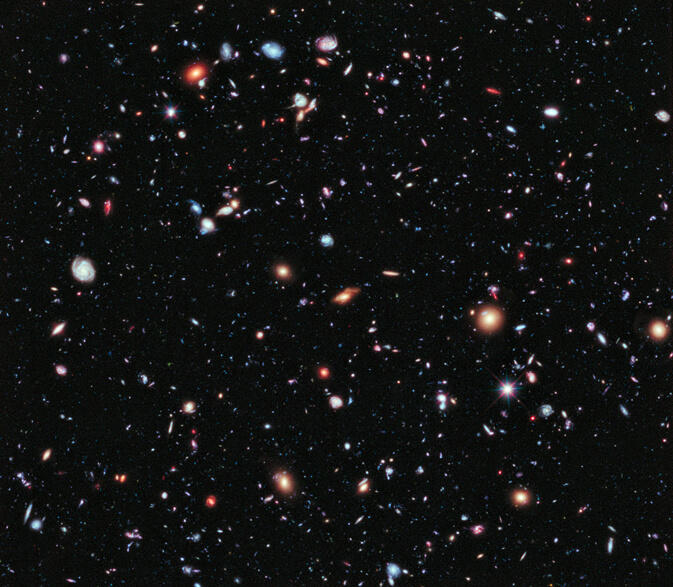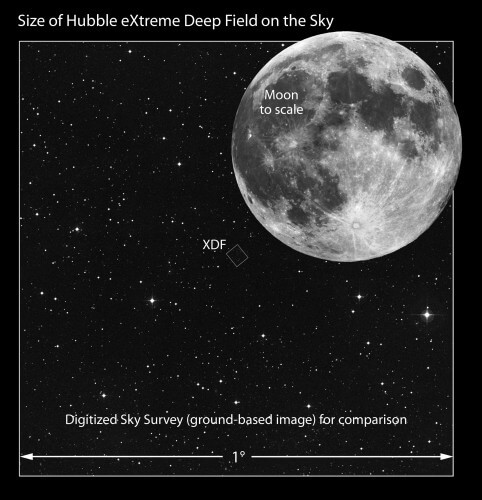The scientists of the Hubble Space Telescope Science Center put together an image that combines 10 years of Hubble photographs of the same small area in the sky

Scientists at the Hubble Space Telescope Science Center recently put together what they call the eXtreme Deep Field, or XDF. The image combines 10 years of Hubble photography of the same small area in the sky at the center of Hubble's original deep field system. The XDF is a small area in the sky in the Fornax group that is only a small fraction of the area that occupies the diameter of the full moon.
The pictures were taken during the free time of the Hubble Space Telescope in 2003-2004. By collecting pale light over many hours of observation, thousands of galaxies, both nearby and very distant, were revealed, making it the most in-depth picture of the universe yet taken.
The new XDF full-color image is much more sensitive and contains about 5,500 galaxies even within the smaller field of view. The fainter galaxies have a brightness of a tenth of a billionth of what the human eye can see.
The attached videoThe original news on the NASA website Focuses on a small area of the sky that the Hubble Space Telescope aimed to perform XDF. The area is located in the southern sky, far from the glow of the Milky Way - the bright plane of our galaxy.
In terms of angular size, the field is a fraction of the angular diameter of the full Moon, but still contains thousands of galaxies spanning all time. (Credit: NASA; ESA; and G. Bacon and Z. Levay, STScI)
Among the galaxies, you can also see spiral galaxies similar to the Milky Way and Andromeda, as well as large and fuzzy red galaxies where the creation of new stars has stopped. These red galaxies are the remnants of dramatic collisions between galaxies and are now in their declining years.
The field is also dotted with many pale and distant galaxies that form the nucleus from which today's large galaxies grew. The history of the galaxies - from the time immediately after the galaxies were formed to the large galaxies of today - such as the Milky Way - unfolds in one impressive picture.
Hubble has observed the southern point in the sky on repeat visits over the last decade for a cumulative time of 50 days with a cumulative exposure duration of 2 million seconds. Over 2,000 images of the same field were taken using Hubble's two main cameras, the Advanced Camera for Surveys and the Wide Field Camera No. 3, which extended Hubble's field of view into the near-infrared range as well.

“The XDF is the deepest image of the sky ever obtained and it reveals the faintest and most distant galaxies ever seen. XDF allows us to probe deeper in time than ever before" says Gareth Illingworth, of the University of California, Santa Cruz, principal investigator of the 2009 Hubble Deep Field program.
The universe is 13.7 billion years old and the XDF reveals galaxies as they looked 13.2 billion years ago. Most of the galaxies in the XDF appear young, small and in growth stages, and usually violent as they collide and merge. The early universe was a period of dramatic birth of galaxies that contained large bright blue stars - much brighter than our Sun. The light from those past events has only just reached Earth now, and therefore the XDF is essentially a "time machine to the distant past". The youngest galaxies in this region existed only 450 million years after the birth of the universe in the Big Bang.
Before the Hubble Space Telescope was launched in 1990, astronomers could barely see normal galaxies up to 7 billion light-years away, about halfway to the beginning of the universe. Observations using ground-based telescopes have failed to discern how galaxies formed and evolved in the early universe.
Hubble provided astronomers with the first look at the true configurations of galaxies when they were young. This provided evidence that galaxies really did change over time. Like watching individual images from a photographic film, the Hubble Space Telescope revealed the appearance of structures in the young universe and the dynamic stages in the evolution of galaxies.
The infrared observation capability that NASA is planning for the James Webb Space Telescope is designed to perform observations such as the XDF. The Webb Space Telescope will detect even fainter galaxies that existed when the universe was only a few hundred million years old. Because of the expansion of the universe, the light from this period was stretched towards even longer wavelengths in the infrared range. The infrared vision of the James Webb Space Telescope will be just right to push the XDF even deeper into the times when the first stars and galaxies formed and illuminate what was until then the "dark age" with intense light.

10 תגובות
You deserve a pat on the back for that.
This is exactly what Alan Gott is talking about in the pat theory. What's new guys???
The universe has never expanded faster than the speed of light
It is not a poor foreground because when you look at a galaxy 13 billion light years away you are looking at it exactly as it was 13 billion years ago
This is not eye catching, the universe initially expanded at a rate faster than the speed of light. The universe spans approximately 100 billion light years, have you asked yourself how they reached this number and not much less than 13.7??
This is because the universe expanded much faster than Pamela Anderson and the speed of light also changed.
Nir
I doubt if this galaxy, despite how young it looks, still exists...
Maybe merged with a galaxy I own and then we'll share the profits..
This is eye catching and I will explain why:
13 billion years ago the material from which the Earth was formed was much closer to the Big Bang region and the same ancient galaxies that were photographed.
Since matter cannot move faster than the speed of light, the light from those distant galaxies was supposed to pass by the material from which the earth was formed a long time ago and therefore today the light was supposed to be billions of light years away from us.
How then does this ancient light suddenly reach the earth??
The conclusion is that apparently the age of the universe is much older than 13 billion years
In light of the clarity of the image - I hereby declare ownership of the third galaxy from the upper right (the bright one, the one with a young 'look'). The announcement is effective immediately.
Dozens of lots for sale in my planets, at bargain prices!
We are inside a black hole and are actually looking at ourselves